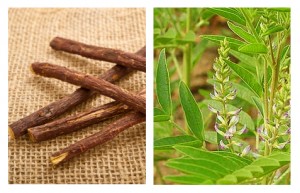Licorice- Boost your immunity
Categories: Seasonal Healers
Licorice (Glycyrrhyza Glabra) Yastimadhu
 Licorice is the sweet root of a plant that has been used for thousands of years as food and medicine. It is an outstanding gift of nature given the plentiful medicinal properties it has. Many ancient civilizations including the Indians, Chinese, Greeks and Egyptians used licorice for its powerful healing effects on multiple body systems. In the classical Ayurvedic texts and day-to-day Ayurvedic practice, licorice is praised and employed as “Jivaniya”, a rejuvenating medicine; “Sandhaniya”, a wound healer; “Medhya”, a tonic for the intellect; and “Kasa Swasaghna”, an effective remedy for cough and asthma. It is also frequently employed in Panchakarma therapies, for internal cleansing purposes
Licorice is the sweet root of a plant that has been used for thousands of years as food and medicine. It is an outstanding gift of nature given the plentiful medicinal properties it has. Many ancient civilizations including the Indians, Chinese, Greeks and Egyptians used licorice for its powerful healing effects on multiple body systems. In the classical Ayurvedic texts and day-to-day Ayurvedic practice, licorice is praised and employed as “Jivaniya”, a rejuvenating medicine; “Sandhaniya”, a wound healer; “Medhya”, a tonic for the intellect; and “Kasa Swasaghna”, an effective remedy for cough and asthma. It is also frequently employed in Panchakarma therapies, for internal cleansing purposes
What does it look like? The licorice plant is a perennial shrub that grows 30-150 cm in height. Licorice roots are long, wrinkled, fibrous branches, with an inner yellow colour, that grow horizontally underground, creating an extensive system of root connections.
Where does it grow? Licorice is cultivated in Southern Europe (Spain, Italy and Greece), Russia and parts of Asia such as China. It grows best in deep, fertile, well drained soils with full sun. Last summer it was announced that licorice fields are back in the UK.
Licorice is popular for all the widely available types of candy, beverages and syrups flavoured with it. Please note that the information on this post does not refer to fabricated licorice sweets, but to the roots of the licorice plant, which are dried, cut and made into a fine powder to be used as a remedy.
What are its properties and uses? Ayurvedic pharmacology describes licorice roots having an intrinsic sweet taste, cooling potency, and oily and dense properties. The synergistic effect created by these qualities results in a sweet root distinguished for its effectiveness in treating infection, inflammation, pain, burning and lack of strength.
Whilst it does its healing work, it excels in building up the immune system, Kapha, and balancing the activities of Vata and Pitta, which regulate the nervous, digestive and endocrine system. It is thus helpful for balancing women’s hormones and menstrual cycle.
The classic Ayurvedic work known as Bhava Prakash describes licorice as an excellent herb for:
- Improving visual acuity.
- Restoring physical strength and skin complexion. Licorice energizes the body from within, and is also effective in taking care of the skin, as it aids in the removal of pimples, discolouration and acne. Licorice mixed with ghee, turmeric and rose water is very effective for this.
- Rejuvenating the reproductive system in men and women
- Fortifying the hair and voice. A licorice brew can be externally applied for hair fall and premature greying. Gargling and drinking licorice tea can relieve sore throat and hoarseness of voice.
- Treating wounds. A paste of licorice powder and ghee can be applied on them to promote healing
- Relieving amongst others conditions, respiratory disorders including tuberculosis. Its nurturing and soothing properties make it a demulcent and emollient, meaning that it softens and soothes tissues and mucous membranes. Licorice mixed with honey and ghee can be licked to decrease phlegm, treat persistent cough and weakening of the respiratory passages.
- In hyper acidity, gastritis and peptic ulcers it controls and heals the irritating effects of acids. It is a good anti-toxic through liver support and protection, and it offers adrenal support as it contains estrogenic chemicals, that make it an anti-stress (Vata) herb.
What does modern research say about it? Licorice’s extensive records have engendered a great amount of research The root has been studied for its effects on skin diseases, and as an immunity regulator, as well as in diabetes, gastritis, hepatitis and vascular changes. This research has yielded a good amount of positive results.
Many clinical studies have focused on licorice’s anti- inflammatory and anti-viral effects, where its active constituent, glycyrrhizin, has shown to be a good anti inflammatory. It has also shown to be protective against influenza, HIV, Hepatitis B and Herpes
Dr Svoboda explains that ” after long-term use licorice can cause salt and water retention and potassium loss, comparable to the effects of Cortisone”. Taking high amounts of licorice over a long period of time can therefore increase blood pressure. Some people are more sensitive to this effect than others, nevertheless, excessive consumption of licorice must be avoided.
Where is it available? Raw licorice roots are available in some health food stores here in the UK. These roots can be cut and boiled to make a tea or infusion. Pukka herbs also offers a nice licorice blend. To yield all medicinal effects of a herb however, it is important to taste it. For best results you may want to take the content out of the capsule before ingesting it.



Comments are closed.